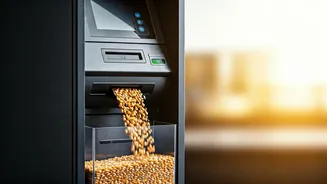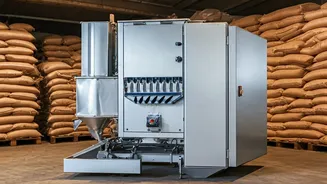Automated Grain Dispensing
The Grain ATMs are designed to dispense grains in a completely automated manner. Beneficiaries insert their ration cards into the machine, which then verifies
their details. Once validated, the machine dispenses the entitled quantity of grains directly. This process minimizes human intervention, thus cutting down on potential errors or discrepancies that could arise in traditional distribution methods. By automating grain distribution, the system aims to make the process smoother, more transparent, and less prone to corruption, benefiting both the government and the end-users. This technological integration represents a considerable leap forward in optimizing public services and ensuring their effective delivery to the intended recipients.
Boosting Efficiency and Transparency
One of the key advantages of Grain ATMs is the enhanced efficiency they bring to the Public Distribution System. The automated nature of these machines ensures that the dispensing process is significantly faster than manual methods. This speed is especially crucial in managing high volumes of distribution and reducing long queues at ration shops. Simultaneously, the system fosters greater transparency by recording all transactions digitally. This allows for easy tracking of grain distribution, preventing pilferage and ensuring that the correct amounts reach the eligible families. The integration of technology in this context not only improves operational efficiency but also builds public trust by providing a clear audit trail of all transactions and minimizing the scope for any irregularities.
How The ATMs Operate
The operation of a Grain ATM is straightforward. Beneficiaries begin by inserting their ration card into the designated slot. The system reads and authenticates the card details, matching them against the database. Upon verification, the user can select their required grain type and quantity. The ATM then dispenses the specified grains in a measured manner, ensuring accurate distribution. The entire process is user-friendly, designed to be easily accessible to all, irrespective of their technological proficiency. This user-centric design makes the process more accessible and aids in reducing the time required to procure grains, thereby enhancing the overall experience for the beneficiaries.
Impact on Beneficiaries
The introduction of Grain ATMs has significantly impacted the beneficiaries by providing a more reliable and convenient method of accessing their rations. The elimination of long wait times and the reduction in human error ensures that the correct quantity of grains is received without undue delay. This contributes to better food security for the families dependent on the Public Distribution System. Moreover, the increased transparency and reduced chances of corruption provide peace of mind to the beneficiaries, creating a system that they can trust. This improved system fosters a stronger relationship between the government and the citizens by ensuring fairness and efficiency in food distribution, thereby improving their quality of life.
Future Prospects of ATMs
Looking forward, the success of Grain ATMs in Gujarat may pave the way for its adoption across other states and territories, potentially transforming the entire Public Distribution System in India. Future improvements could include integrating additional features such as multilingual support and advanced reporting tools to enhance user experience and administrative oversight. Furthermore, these ATMs could be expanded to include other essential food items, broadening their usefulness. By embracing this kind of technology, the government can create a more efficient, transparent, and responsive system for providing essential services to its citizens, demonstrating a commitment to continuous improvement and innovation.















